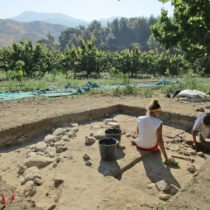I. From adolescence to maturity: In order to present a brief survey on sexual love in ancient Greece we will simply follow the various phases of sexual development of the adult, from adolescence to maturity, examining at the same time the conditions and rules justifying sexuality.
1. Adolescence: It is quite significant that the vocabulary of the ancient Greek language does not distinctly express the differentiation of the sexes during the infantile age. Thus, a unique word-term “παiς” applies both to girls and to boys and only the article suggests the gender. Language, however, cannot be considered the only indication of social structure. Indeed, both in Archaic Sparta and in the Hellenistic state, the boys were separated from their families soon after their seventh birthday. The two basic means of education both in Sparta and Classical Athens, were the same; gymnastic education that aimed at the development of the students’ mental and physical potential, and artistic education that aimed at imparting knowledge of and training in the art of the Muses. Thus young Greeks spent most of their time in the gymnasium. This location provided the background for the first testimonies of his sex life. The numerous representations on pottery inform us of the age of the partners of this first erotic relationship. The homosexual relation involves a mature man and an ephoebos. In this institutional homosexual love the lover appears both as the tutor of the beloved and as the guarantor of the moral virtues and knowledge that the youth ought to obtain through this relation. In this way, homosexual and educational qualities are closely related. During adolescence, girls were also educated via similar homosexual relations. If, however, more emphasis is given to the physical appearance of girls than to their moral perfection, the reason is that beauty in a female unleashes the power that inspires love and calls a man to sexual intercourse.
2. Marriage: The prerequisites of maturity for a man in ancient Greece are citizen status and enrollment in the army. While for a woman, the prerequisite is the ritual of marriage.
3. Beyond Marriage: Since Homeric times heroes are seen settling concubines in their homes. In theatrical plays and in the speeches of Athenian orators the concubine seems to have equal rights with the legal wife regarding her children. However, apart from the sexual activity a man had in his home, he was also entitled to retain relations with prostitutes. According to Demosthenes, “prostitutes were for sexual pleasure, concubines for everyday care and wives for the creation of legal descendents and the guarding of the house”. These manifold, delicate, social relations caused social crises that varied from disapproval to acceptance.
II. The rule and the exception: As in every society, so in the Greek, there is a dominant sexual rule. For the Greek of the Classical period his sexual activity is accompanied by feelings of love only under certain circumstances; in marital relations, homosexual relations, relations with concubines or prostitutes. These relations are characterized by duration in time and by an exchange based on friendship, that is a mutual relation founded on trust.
The conclusion we draw is that Eros creates between males and females a network of relations that stands above simple sexual satisfaction; educational homosexuality, economic benefit from marriage and reproduction of the species through the institution of marriage.

